Subscriber OnlyHistory
The Hill of Tara’s Lia Fáil has a fascinating history - but is it the original?
In 1899, religious zealots called the British Israelites dug up a substantial portion of a monument called Ráth na Seanad, the Rath of the Synods, in the belief the Ark of the Covenant was buried there















